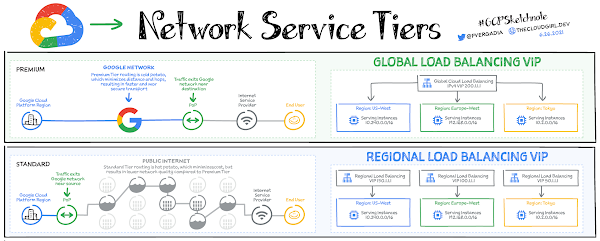With Network Service Tiers, Google Cloud is the first major public cloud to offer a tiered cloud network. Two tiers are available: Premium Tier and Standard Tier.
Premium Tier
Premium Tier delivers traffic from external systems to Google Cloud resources by using Google’s highly reliable, low-latency global network. This network consists of an extensive private fiber network with over 100 points of presence (PoPs) around the globe. This network is designed to tolerate multiple failures and disruptions while still delivering traffic.
Premium Tier supports both regional external IP addresses and global external IP addresses for VM instances and load balancers. All global external IP addresses must use Premium Tier. Applications that require high performance and availability, such as those that use HTTP(S), TCP proxy, or SSL proxy load balancers with backends in more than one region, require Premium Tier. Premium Tier is ideal for customers with users in multiple locations worldwide who need the best network performance and reliability.
With Premium Tier, incoming traffic from the internet enters Google’s high-performance network at the PoP closest to the sending system. Within the Google network, traffic is routed from that PoP to the VM in your Virtual Private Cloud (VPC) network or closest Cloud Storage bucket. Outbound traffic is sent through the network, exiting at the PoP closest to its destination. This routing method minimizes congestion and maximizes performance by reducing the number of hops between end users and the PoPs closest to them.
Standard Tier
Standard Tier delivers traffic from external systems to Google Cloud resources by routing it over the internet. It leverages the double redundancy of Google’s network only up to the point where a Google data center connects to a peering PoP. Packets that leave the Google network are delivered using the public internet and are subject to the reliability of intervening transit providers and ISPs. Standard Tier provides network quality and reliability comparable to that of other cloud providers.
Regional external IP addresses can use either Premium Tier or Standard Tier. Standard Tier is priced lower than Premium Tier because traffic from systems on the internet is routed over transit (ISP) networks before being sent to VMs in your VPC network or regional Cloud Storage buckets. Standard Tier outbound traffic normally exits Google’s network from the same region used by the sending VM or Cloud Storage bucket, regardless of its destination. In rare cases, such as during a network event, traffic might not be able to travel out the closest exit and might be sent out another exit, perhaps in another region.
Standard Tier offers a lower-cost alternative for applications that are not latency or performance sensitive. It is also good for use cases where deploying VM instances or using Cloud Storage in a single region can work.
Choosing a tier
It is important to choose the tier that best meets your needs. The decision tree can help you decide if Standard Tier or Premium Tier is right for your use case. Because you choose a tier at the resource level—such as the external IP address for a load balancer or VM—you can use Standard Tier for some resources and Premium Tier for others. If you are not sure which tier to use, choose the default Premium Tier and then consider a switch to Standard Tier if you later determine that it’s a better fit for your use case.
For a more in-depth look into Network Service Tiers check out the documentation.
For more #GCPSketchnote, follow the GitHub repo. For similar cloud content follow me on Twitter @pvergadia and keep an eye out on thecloudgirl.dev.
Cloud BlogRead More


